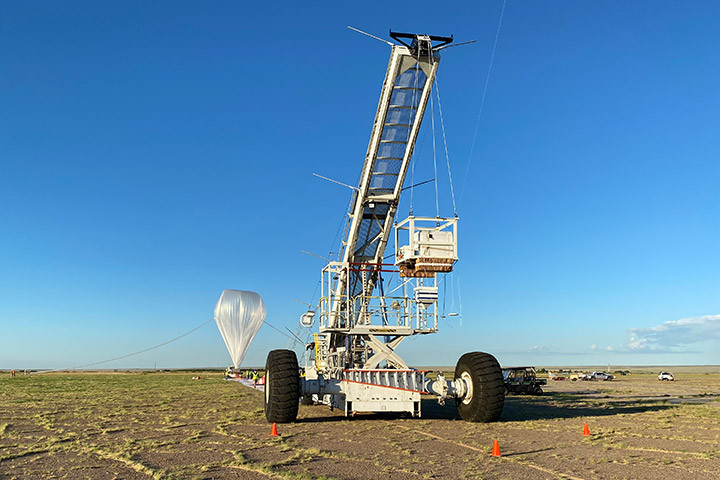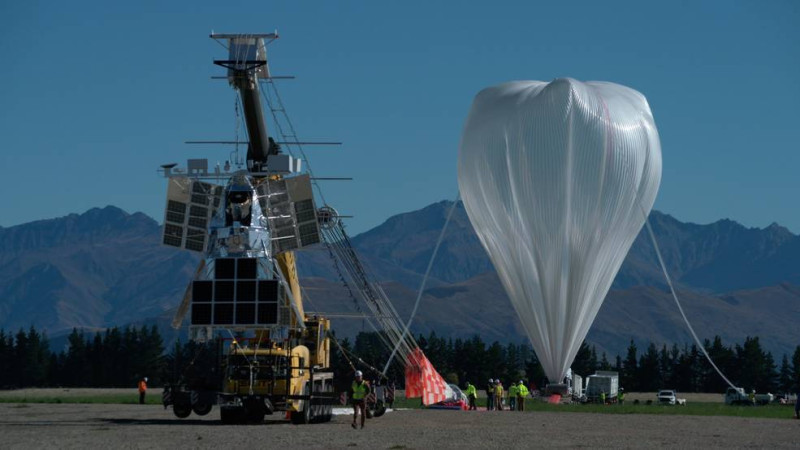“Mother Nature shone beautifully today giving us the perfect conditions for a brilliant launch,” said Debbie Fairbrother, head of NASA’s Balloon Science Program.
NASA’s Science Balloon Program successfully launched its football-field-sized superpressure balloon (SPB) from New Zealand’s Wānaka Airport at 11:42 a.m. Sunday, April 16 (7:42 p.m. April 15 in American Eastern Time), on a mission scheduled for 100 or more days.
“Mother Nature shone beautifully today giving us the perfect conditions for a brilliant launch,” said Debbie Fairbrother, head of NASA’s Balloon Science Program. “I am excited about this mission and the cutting-edge science it will perform.”
The balloon will float at 110,000 feet (33.5 km) with winds carrying it around the mid-latitude zone of the Southern Hemisphere.
NASA invites the public to watch these missions as they fly through the mid-latitudes of the Southern Hemisphere. A balloon’s flight path is controlled by the wind speed and direction at the height of the float. The missions will spend most of their time over water, and for any land crossings, NASA works with the US State Department to coordinate country overflight approvals. Real-time tracking of these flights is publicly available here . In addition, NASA publishes balloon launch and tracking information over the Internet at www.nasa.gov/balloons and on all NASA social media platforms.
While validating hyperpressure balloon technology is the main flight goal, the balloon also carries the Super Pressure Balloon Imaging Telescope (SuperBIT), from Princeton University, which uses a wide field of view to image large galaxy clusters from a balloon platform in a near-space environment. By measuring the way these massive objects distort the space around them, also called “weak gravitational lensing”, SuperBIT will be able to map the dark matter present in these clusters.
A second SPB flight is planned and will fly the Extreme Universe Space Observatory 2 (EUSO-2), a mission from the University of Chicago that aims to build on data collected during a 2017 mission. EUSO-2 will detect extremely high-energy cosmic ray particles beyond our galaxy as they penetrate Earth’s atmosphere. The origin of these particles is not well known, so the data collected by EUSO-2 will help solve this scientific mystery.
Maintaining a constant floating height in the stratosphere is a formidable challenge for airborne systems, including balloons. Most standard heavyweight zero-pressure balloons can vary in altitude up to 45,000 feet (13.7 km) due to the alternating heating and cooling of the day-night cycle. In response, mission operators typically release excess weight in the form of ballast to maintain altitude. The SPB, in contrast, is designed to maintain positive internal pressure and shape regardless of its environment, which keeps the balloon at a constant buoyancy without shedding ballast.
The 18.8 million cubic feet (532,000 cubic meters) balloon is filled with helium and is about the size of a football field when fully inflated to the float’s operating altitude of 110,000 feet (33.5 kilometers). Wānaka is NASA’s exclusive launch site for mid-latitude, long-duration balloon missions.
NASA launches SPBs from New Zealand in partnership with Queenstown Airport Corporation, Queenstown Lake District Council, New Zealand Space Agency and Airways New Zealand.
NASA’s Wallops Flight Facility in Virginia manages NASA’s science balloon flight program with 10 to 15 flights each year from launch sites around the world. Peraton, which operates the NASA Balloon Science Field (CSBF) in Texas, provides mission planning, engineering services and field operations for NASA’s balloon science program. The CSBF team has launched more than 1,700 scientific balloons in nearly 40 years of operation. NASA balloons are manufactured by Aerostar. NASA’s Science Balloon Program is funded by the Astrophysics Division of the Science Mission Directorate at NASA Headquarters.
Source :Skai
I am Terrance Carlson, author at News Bulletin 247. I mostly cover technology news and I have been working in this field for a long time. I have a lot of experience and I am highly knowledgeable in this area. I am a very reliable source of information and I always make sure to provide accurate news to my readers.












